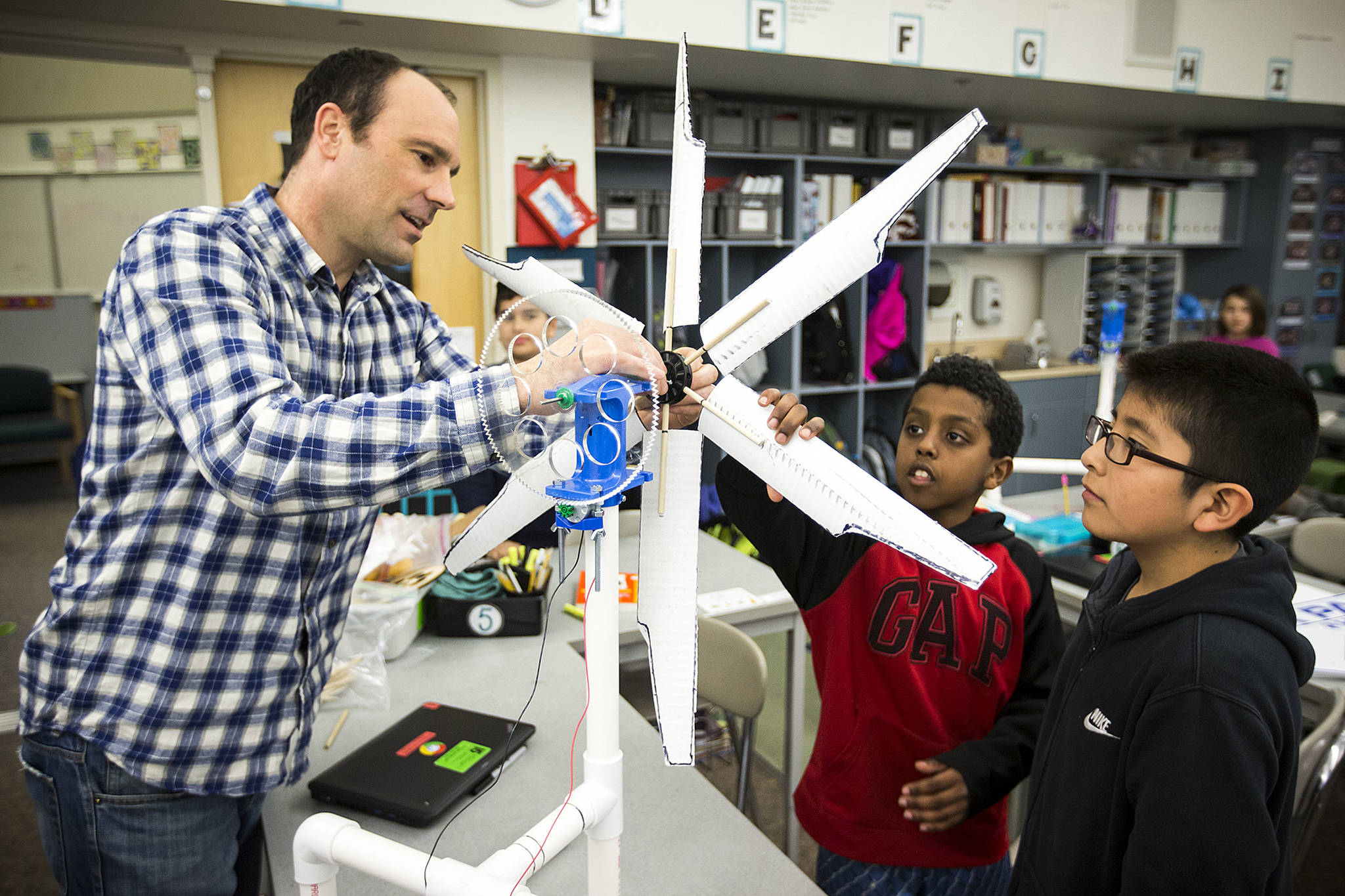EDMONDS — Pairs of students pressed rulers against the blades of their homemade wind turbines and marked off measurements for attaching them to the bases and towers they’d made of PVC pipe.
Some teams decided to try four wide blades, others six narrow ones. The bases all looked different and the blades were of various lengths and materials. Students tested angles to see how to best catch the wind.
Fourteen fourth- and fifth-grade students at Chase Lake Elementary School are getting ready for a regional competition. Their goal is to design and build a turbine that produces as much renewable energy as possible. It’s part of a national program called the KidWind Challenge.
The regional competition is set for April 1 in Seattle. The top three finishers qualify for nationals. This is the third year Chase Lake has participated.
Teacher Jody Wallis leads students through their projects. On Tuesday, he urged them to start attaching blades to the rest of their turbines, which sat on desks or the classroom floor.
Wallis explained that students needed to decide what variables they want to test so they can improve their designs. Should they try fewer or more blades, or change the angle or size? Four white box fans set up in one corner of the room provided a wind source for testing.
Claire August, 9, and Olivia Skalley, 10, were trying two-blade shapes, one with a flat end and one with a curve. Claire expected her favorite part of the six-week project to be seeing how fast those blades can go. Olivia was excited to have learned how to build something from the ground up.
“We didn’t know how to do it at first,” she said. “Now we do.”
Noah Henok and Cris Martinez, both 11, decided to experiment with the number and length of blades. They were working on carefully attaching their first few so they wouldn’t collide while spinning.
Roxana Gabu and Eldina Tirak, both 10, measured the parts of their turbine thoroughly. They were getting ready to attach wooden dowels to the blades, then connect those dowels to a circular spinning mechanism. They decided they only wanted 2 centimeters of dowel between the edge of the blade and the rest of the machinery.
“If we have too much space, we lose all that wind,” Roxana said.
Roxana and Eldina agreed that the best part of the project was getting to learn something they normally wouldn’t in class. Eldina has become interested in renewable energy, which she didn’t know much about before this project.
The trick to building a turbine, they said, is to measure and know what math is needed for testing different designs. They also warned that a project like this needs to be fun. Otherwise, why stay after school?
Aaliyah Kaynan, 10, worked alone Tuesday because her partner couldn’t be there. That was a challenge. Building a turbine is a two-person job, she said.
Still, she had fun. She enjoyed designing the base and tower, then putting it together and seeing the design in action. She thinks she might be interested in engineering when she grows up. She’s learned the importance of planning before assembling.
“You want to design everything first,” she said. “Draw it out before you do it.”
Ethan Hudson and Eli Delfel, both 10, sketched out a blade design on a yellow piece of paper. Their stand was finished but they needed to figure out the size and shape for their blades.
Meanwhile, Millie Naranjo and Monica Chavarin, also 10, were starting to make two extra blades. They thought they wanted four but decided to try six. They participated last year in the KidWind Challenge. This year, they’re trying a new design. They have a methodical approach, testing one variable at a time to see what works best.
Yousif Alsaadi and Edgar Andrade, both 10, had a mishap Tuesday while trying to attach their blades. Their lesson of the day was not to touch anything that has just been glued down. One of their four wide blades fell off the turbine.
Yousif found the freedom of the project fun. He likes that teams are able to try their own designs. No two turbines in the room looked the same.
Edgar offered some advice for his fellow students.
“Work hard. Work together,” he said. “Don’t touch right after you glue it.”
Kari Bray: 425-339-3439; kbray@heraldnet.com.
Talk to us
> Give us your news tips.
> Send us a letter to the editor.
> More Herald contact information.


























